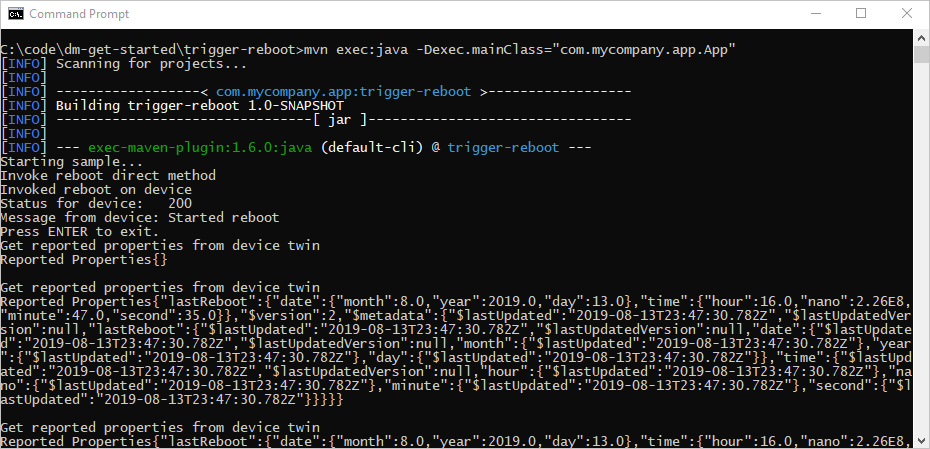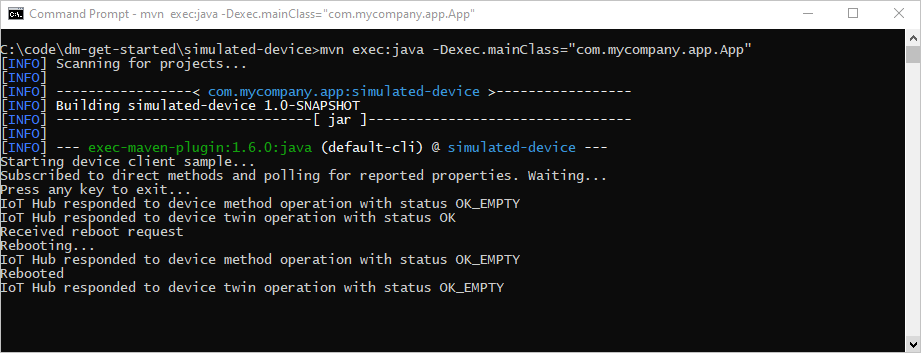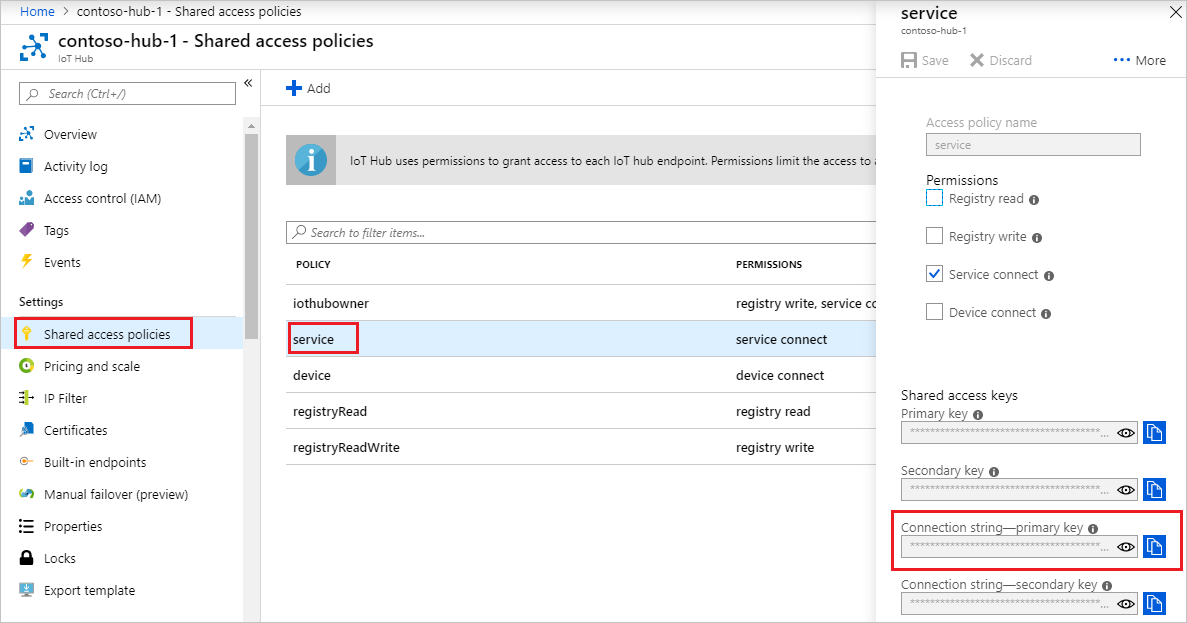设备管理入门 (Java)
本文介绍如何创建:
simulated-device:一个模拟设备应用,它使用直接方法重新启动设备并报告上次重新启动时间。 直接方法是从云中调用的。
trigger-reboot:一个 Java 应用,通过 IoT 中心调用模拟设备应用中的直接方法。 它显示响应和更新的报告属性。
注意
有关 SDK 的信息(可以使用这些 SDK 构建在设备和解决方案后端上运行的应用程序),请参阅 Azure IoT SDK。
先决条件
已注册的设备。 在 Azure 门户中注册一个。
Java SE 开发工具包 8。 请确保在“长期支持”下选择“Java 8”以获取 JDK 8 的下载。
确保已在防火墙中打开端口 8883。 本文中的设备示例使用 MQTT 协议,该协议通过端口 8883 进行通信。 在某些公司和教育网络环境中,此端口可能被阻止。 有关解决此问题的更多信息和方法,请参阅连接到 IoT 中心(MQTT)。
使用直接方法创建设备应用
本部分中将创建一个模拟设备的 Java 控制台应用。 该应用侦听 IoT 中心发出的重启直接方法调用并快速响应该调用。 然后该应用会休眠一段时间,以模拟重启过程,之后该应用会使用报告属性通知 trigger-reboot 后端应用重启已完成。
在 dm-get-started 文件夹中,通过命令提示符使用以下命令创建名为 simulated-device 的 Maven 项目:
mvn archetype:generate -DgroupId=com.mycompany.app -DartifactId=simulated-device -DarchetypeArtifactId=maven-archetype-quickstart -DinteractiveMode=false在命令提示符下,导航到 simulated-device 文件夹。
使用文本编辑器打开 simulated-device 文件夹中的 pom.xml 文件,并在 dependencies 节点中添加以下依赖项 。 此依赖项使得可以使用应用中的 iot-service-client 包来与 IoT 中心进行通信:
<dependency> <groupId>com.microsoft.azure.sdk.iot</groupId> <artifactId>iot-device-client</artifactId> <version>1.17.5</version> </dependency>注意
可以使用 Maven 搜索检查是否有最新版本的 iot-device-client。
将以下依赖项添加到 dependencies 节点。 此依赖项为 Apache SLF4J 日志记录外观配置 NOP,设备客户端 SDK 使用它实现日志记录。 此配置是可选的,但是如果省略此配置,则在运行该应用时,可能会在控制台中看到警告。 有关设备客户端 SDK 中的日志记录的详细信息,请参阅适用于 Java 的 Azure IoT 设备 SDK 示例自述文件中的日志记录。
<dependency> <groupId>org.slf4j</groupId> <artifactId>slf4j-nop</artifactId> <version>1.7.28</version> </dependency>在 dependencies 节点后添加以下 build 节点。 此配置指示 Maven 使用 Java 1.8 来生成应用:
<build> <plugins> <plugin> <groupId>org.apache.maven.plugins</groupId> <artifactId>maven-compiler-plugin</artifactId> <version>3.3</version> <configuration> <source>1.8</source> <target>1.8</target> </configuration> </plugin> </plugins> </build>保存并关闭 pom.xml 文件。
使用文本编辑器打开 simulated-device\src\main\java\com\mycompany\app\App.java 源文件。
在该文件中添加以下 import 语句:
import com.microsoft.azure.sdk.iot.device.*; import com.microsoft.azure.sdk.iot.device.DeviceTwin.*; import java.io.IOException; import java.net.URISyntaxException; import java.time.LocalDateTime; import java.util.Scanner; import java.util.Set; import java.util.HashSet;将以下类级变量添加到 App 类。 将
{yourdeviceconnectionstring}替换为在 IoT 中心注册设备时看到的设备连接字符串:private static final int METHOD_SUCCESS = 200; private static final int METHOD_NOT_DEFINED = 404; private static IotHubClientProtocol protocol = IotHubClientProtocol.MQTT; private static String connString = "{yourdeviceconnectionstring}"; private static DeviceClient client;若要为直接方法状态事件实现回调处理程序,请将以下嵌套类添加到 App 类:
protected static class DirectMethodStatusCallback implements IotHubEventCallback { public void execute(IotHubStatusCode status, Object context) { System.out.println("IoT Hub responded to device method operation with status " + status.name()); } }若要为设备孪生状态事件实现回调处理程序,请将以下嵌套类添加到 App 类:
protected static class DeviceTwinStatusCallback implements IotHubEventCallback { public void execute(IotHubStatusCode status, Object context) { System.out.println("IoT Hub responded to device twin operation with status " + status.name()); } }若要为属性事件实现回调处理程序,请将以下嵌套类添加到 App 类:
protected static class PropertyCallback implements PropertyCallBack<String, String> { public void PropertyCall(String propertyKey, String propertyValue, Object context) { System.out.println("PropertyKey: " + propertyKey); System.out.println("PropertyKvalue: " + propertyKey); } }若要实现一个模拟设备重启的线程,请将以下嵌套类添加到 App 类。 线程会休眠五秒,然后设置 lastReboot 报告属性:
protected static class RebootDeviceThread implements Runnable { public void run() { try { System.out.println("Rebooting..."); Thread.sleep(5000); Property property = new Property("lastReboot", LocalDateTime.now()); Set<Property> properties = new HashSet<Property>(); properties.add(property); client.sendReportedProperties(properties); System.out.println("Rebooted"); } catch (Exception ex) { System.out.println("Exception in reboot thread: " + ex.getMessage()); } } }若要在设备上实现直接方法,请将以下嵌套类添加到 App 类。 模拟应用接收到重启直接方法的调用时,会向调用方返回确认,然后启动处理重启的线程:
protected static class DirectMethodCallback implements com.microsoft.azure.sdk.iot.device.DeviceTwin.DeviceMethodCallback { @Override public DeviceMethodData call(String methodName, Object methodData, Object context) { DeviceMethodData deviceMethodData; switch (methodName) { case "reboot" : { int status = METHOD_SUCCESS; System.out.println("Received reboot request"); deviceMethodData = new DeviceMethodData(status, "Started reboot"); RebootDeviceThread rebootThread = new RebootDeviceThread(); Thread t = new Thread(rebootThread); t.start(); break; } default: { int status = METHOD_NOT_DEFINED; deviceMethodData = new DeviceMethodData(status, "Not defined direct method " + methodName); } } return deviceMethodData; } }修改 main 方法的签名以引发以下异常:
public static void main(String[] args) throws IOException, URISyntaxException若要实例化 DeviceClient,请将 main 方法中的代码替换为以下代码:
System.out.println("Starting device client sample..."); client = new DeviceClient(connString, protocol);若要开始侦听直接方法调用,请将以下代码添加到 main 方法:
try { client.open(); client.subscribeToDeviceMethod(new DirectMethodCallback(), null, new DirectMethodStatusCallback(), null); client.startDeviceTwin(new DeviceTwinStatusCallback(), null, new PropertyCallback(), null); System.out.println("Subscribed to direct methods and polling for reported properties. Waiting..."); } catch (Exception e) { System.out.println("On exception, shutting down \n" + " Cause: " + e.getCause() + " \n" + e.getMessage()); client.close(); System.out.println("Shutting down..."); }若要关闭设备模拟器,请将以下代码添加到 main 方法:
System.out.println("Press any key to exit..."); Scanner scanner = new Scanner(System.in); scanner.nextLine(); scanner.close(); client.close(); System.out.println("Shutting down...");保存并关闭 simulated-device\src\main\java\com\mycompany\app\App.java 文件。
生成 simulated-device 应用并更正任何错误。 在命令提示符下,导航到 simulated-device 文件夹并运行以下命令:
mvn clean package -DskipTests
获取 IoT 中心连接字符串
在本文中,你将创建一项在设备上调用直接方法的后端服务。 若要通过 IoT 中心在设备上调用直接方法,服务需要“服务连接”权限。 默认情况下,每个 IoT 中心都使用名为“服务”的共享访问策略创建,该策略会授予此权限。
若要获取 service策略的 IoT 中心连接字符串,请执行以下步骤:
在 Azure 门户中,选择“资源组”。 选择中心所在的资源组,然后从资源列表中选择中心。
在 IoT 中心的左侧窗格上,选择“共享访问策略”。
在策略列表中,选择“service”策略。
复制“主连接字符串”并保存该值。
有关 IoT 中心共享访问策略和权限的详细信息,请参阅访问控制和权限。
创建服务应用以触发重新启动
本部分将创建一个进行如下操作的 Java 控制台应用:
在模拟设备应用中调用重启直接方法。
显示响应。
轮询设备发送的报告属性,以确定重启的完成时间。
此控制台应用连接到 IoT 中心,以便调用该直接方法并读取报告属性。
创建名为 dm-get-started 的空文件夹。
在 dm-get-started 文件夹中,通过命令提示符使用以下命令创建名为 trigger-reboot 的 Maven 项目:
mvn archetype:generate -DgroupId=com.mycompany.app -DartifactId=trigger-reboot -DarchetypeArtifactId=maven-archetype-quickstart -DinteractiveMode=false在命令提示符下,导航到 trigger-reboot 文件夹。
使用文本编辑器打开 trigger-reboot 文件夹中的 pom.xml 文件,并在 dependencies 节点中添加以下依赖项 。 此依赖项使得可以使用应用中的 iot-service-client 包来与 IoT 中心进行通信:
<dependency> <groupId>com.microsoft.azure.sdk.iot</groupId> <artifactId>iot-service-client</artifactId> <version>1.17.1</version> <type>jar</type> </dependency>注意
可以使用 Maven 搜索检查是否有最新版本的 iot-service-client。
在 dependencies 节点后添加以下 build 节点。 此配置指示 Maven 使用 Java 1.8 来生成应用:
<build> <plugins> <plugin> <groupId>org.apache.maven.plugins</groupId> <artifactId>maven-compiler-plugin</artifactId> <version>3.3</version> <configuration> <source>1.8</source> <target>1.8</target> </configuration> </plugin> </plugins> </build>保存并关闭 pom.xml 文件。
使用文本编辑器打开 trigger-reboot\src\main\java\com\mycompany\app\App.java 源文件。
在该文件中添加以下 import 语句:
import com.microsoft.azure.sdk.iot.service.devicetwin.DeviceMethod; import com.microsoft.azure.sdk.iot.service.devicetwin.MethodResult; import com.microsoft.azure.sdk.iot.service.exceptions.IotHubException; import com.microsoft.azure.sdk.iot.service.devicetwin.DeviceTwin; import com.microsoft.azure.sdk.iot.service.devicetwin.DeviceTwinDevice; import java.io.IOException; import java.util.concurrent.TimeUnit; import java.util.concurrent.Executors; import java.util.concurrent.ExecutorService;将以下类级变量添加到 App 类。 将
{youriothubconnectionstring}替换为以前在获取 IoT 中心连接字符串中复制的 IoT 中心连接字符串:public static final String iotHubConnectionString = "{youriothubconnectionstring}"; public static final String deviceId = "myDeviceId"; private static final String methodName = "reboot"; private static final Long responseTimeout = TimeUnit.SECONDS.toSeconds(30); private static final Long connectTimeout = TimeUnit.SECONDS.toSeconds(5);若要实现每隔 10 秒读取一次设备孪生提供的报告属性的线程,请将以下嵌套类添加到 App 类:
private static class ShowReportedProperties implements Runnable { public void run() { try { DeviceTwin deviceTwins = DeviceTwin.createFromConnectionString(iotHubConnectionString); DeviceTwinDevice twinDevice = new DeviceTwinDevice(deviceId); while (true) { System.out.println("Get reported properties from device twin"); deviceTwins.getTwin(twinDevice); System.out.println(twinDevice.reportedPropertiesToString()); Thread.sleep(10000); } } catch (Exception ex) { System.out.println("Exception reading reported properties: " + ex.getMessage()); } } }将 main 方法签名修改为抛出以下异常:
public static void main(String[] args) throws IOException若要在模拟设备上调用重启直接方法,请将 main 方法中的代码替换为以下代码:
System.out.println("Starting sample..."); DeviceMethod methodClient = DeviceMethod.createFromConnectionString(iotHubConnectionString); try { System.out.println("Invoke reboot direct method"); MethodResult result = methodClient.invoke(deviceId, methodName, responseTimeout, connectTimeout, null); if(result == null) { throw new IOException("Invoke direct method reboot returns null"); } System.out.println("Invoked reboot on device"); System.out.println("Status for device: " + result.getStatus()); System.out.println("Message from device: " + result.getPayload()); } catch (IotHubException e) { System.out.println(e.getMessage()); }若要启动轮询模拟设备提供的报告属性的线程,请将以下代码添加到 main 方法:
ShowReportedProperties showReportedProperties = new ShowReportedProperties(); ExecutorService executor = Executors.newFixedThreadPool(1); executor.execute(showReportedProperties);若要能够停止应用,请将以下代码添加到 main 方法:
System.out.println("Press ENTER to exit."); System.in.read(); executor.shutdownNow(); System.out.println("Shutting down sample...");保存并关闭 trigger-reboot\src\main\java\com\mycompany\app\App.java 文件。
生成 trigger-reboot 后端应用并更正任何错误。 在命令提示符下,导航到 trigger-reboot 文件夹并运行以下命令:
mvn clean package -DskipTests
运行应用
现在可以运行应用了。
在命令提示符下,在 simulated-device 文件夹中运行以下命令,开始侦听 IoT 中心发出的重启方法调用:
mvn exec:java -Dexec.mainClass="com.mycompany.app.App"
在命令提示符下,在 trigger-reboot 文件夹中运行以下命令,在模拟设备上从 IoT 中心调用重启方法:
mvn exec:java -Dexec.mainClass="com.mycompany.app.App"
模拟设备对重启直接方法调用做出响应:

自定义和扩展设备管理操作
IoT 解决方案可扩展已定义的设备管理模式集,或通过使用设备孪生和云到设备方法基元启用自定义模式。 设备管理操作的其他示例包括恢复出厂设置、固件更新、软件更新、电源管理、网络和连接管理以及数据加密。
设备维护时段
通常情况下,将设备配置为在某一时间执行操作,以最大程度减少中断和停机时间。 设备维护时段是一种常用模式,用于定义设备应更新其配置的时间。 后端解决方案使用设备克隆所需属性在设备上定义并激活策略,以启用维护时段。 当设备收到维护时段策略时,它可以使用设备克隆报告属性报告策略状态。 然后,后端应用可以使用设备克隆查询来证明设备和每个策略的符合性。
后续步骤
本文使用直接方法触发设备上的远程重新启动。 使用报告属性报告设备上次重新启动时间,并查询设备孪生从云中发现设备上次重新启动时间。
若要继续完成 IoT 中心和设备管理模式(如远程无线固件更新)的入门内容,请参阅如何更新固件。
若要了解如何扩展 IoT 解决方案以及在多个设备上计划方法调用,请参阅计划和广播作业。
